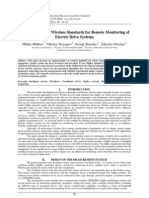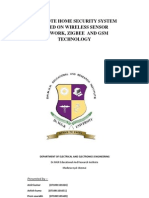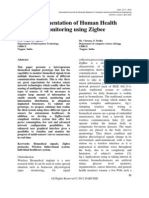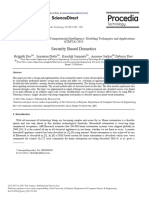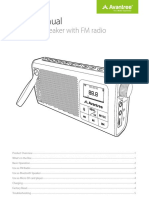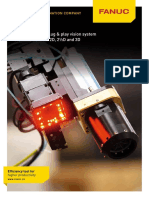Design and Implementation of Environment Sensing System Based On Gsm/Gprs Using Embedded Controlled Sensor Network
Design and Implementation of Environment Sensing System Based On Gsm/Gprs Using Embedded Controlled Sensor Network
Uploaded by
samsath10Copyright:
Available Formats
Design and Implementation of Environment Sensing System Based On Gsm/Gprs Using Embedded Controlled Sensor Network
Design and Implementation of Environment Sensing System Based On Gsm/Gprs Using Embedded Controlled Sensor Network
Uploaded by
samsath10Original Description:
Original Title
Copyright
Available Formats
Share this document
Did you find this document useful?
Is this content inappropriate?
Copyright:
Available Formats
Design and Implementation of Environment Sensing System Based On Gsm/Gprs Using Embedded Controlled Sensor Network
Design and Implementation of Environment Sensing System Based On Gsm/Gprs Using Embedded Controlled Sensor Network
Uploaded by
samsath10Copyright:
Available Formats
International Journal of Combined Research & Development (IJCRD )
eISSN:2321-225X; pISSN:2321-2241 Volume: 2; Issue: 5; May -2014
DESIGN AND IMPLEMENTATION OF ENVIRONMENT
SENSING SYSTEM BASED ON GSM/GPRS USING EMBEDDED
CONTROLLED SENSOR NETWORK
Shrikant M.B1, Basavanagouda G2
1
Student of Department of E&CE (VLSI&ES) TJIT, Bangalore, India
2
Assistant Professor, E&CE department, TJIT, Bangalore, India
Abstract- This paper presents the design and
implementation of environment sensing system
based on GSM/GPRS using embedded controlled
sensor network. Sensor networks are dense wireless
networks of small, low-cost sensors, which collect
and disseminate environmental data. Wireless
sensor networks facilitate monitoring and
controlling of physical environments from remote
locations with better accuracy. They have
applications in a variety of fields such as
environmental monitoring, military purposes and
gathering sensing information in inhospitable
locations. Sensor nodes have various energy and
computational constraints because of their
inexpensive nature and ad-hoc method of
deployment. Existing systems are bulky, very costly
and difficult to maintain. In the Proposed system
ARM based microcontroller and wireless sensors
are used to control various parameters and monitor
the information using GPRS/GSM and Zigbee
technologies. This system has simpler features
designed with the objective of low cost and effective
with less power consumption using sensors for
remote monitoring and controlling devices which
are controlled via SMS using GSM.
Index
Terms-
Embedded
controlled
sensor
networks, Zigbee, GPRS/GSM
I.INTRODUCTION
Recent technological improvements have made the
deployment of small, inexpensive, low-power,
distributed devices, which are capable of local
processing and wireless communication, a reality.
Such nodes are called as sensor nodes. Each sensor
node is capable of only a limited amount of
processing. But when coordinated with the
information from a large number of other nodes, they
have the ability to measure a given physical
environment in great detail. Thus, a sensor network
can be described as a collection of sensor nodes
which co-ordinate to perform some specific action.
Unlike traditional networks, sensor networks depend
on dense deployment and co-ordination to carry out
their tasks. There is revolution of the sensor
networks which have also come up with various
applications like surveillance, traffic control,
environmental and wildlife monitoring, agricultural
application, home automation and industrial
process
control .Embedded controlled
sensor
networks (ECSN) are mainly designed to be
application- specific
so
that
the
energy
consumption is minimum as the battery-powered
nodes demand life-time of several months or even
a few years. Block diagram of ECSN is as shown in
figure1.
The available technologies are Bluetooth, Wi-Fi, WiMax, wireless mobile Ad-hoc network (WMANET),
UMB, wireless HART, Bluetooth and ZigBee.
Embedded sensor networks are formed by
communicating over wireless links without using a
fixed networked infrastructure controlled by
microcontroller. Zigbee is the name for a shortrange, low-power, low-cost, and low-data-rate
wireless multi-hop networking technology. Block
diagram of ECSN consists of a master circuit which
is connected to number of sub networks
consisting of the various slaves. Master circuit is
www.ijcrd.com
Page 35
International Journal of Combined Research & Development (IJCRD )
eISSN:2321-225X; pISSN:2321-2241 Volume: 2; Issue: 5; May -2014
connected by a personal computer which can be
controlled by the internet. Wireless technologies
for environment sensing system -offers many benefits
to the users.
toggling its output when sudden changes occur, such
as when there is motion.
2) Temperature monitoring and control node
II. METHODOLOGY
Design and implementation of environment sensing
system based on GSM/GPRS using embedded
controlled sensor network allows new level of
comfort in industrial and commercial application
and it can also manage the energy consumption
efficiently which in turns promotes the saving.
The hardware unit of prototype of system is
represented by block diagram bellow. It contains a
LPC2148 as main processing unit and it gets the
input from various sensors (PIR, Temperature, and
humidity sensor). From the data obtained from sensor
nodes, the program controls the devices to achieve
system requirements. It also uses a LCD display to
display the data obtained from sensors. The
requirement of the system is to monitor and regulate
the various sensors parameter to user defined value
and controlled around predefined values. Also detect
the human motion by PIR sensor. The environment
sensing system consists of three sensor nodes and
they are,
1) Human motion detection and control node
Human motion detection we are using PIR (Passive
Infra-Red) Sensor is a pyroelectric device that detects
motion by measuring changes in the infrared levels
emitted by surrounding objects and it is indicated by
BUZZER. This motion can be detected by checking
for a high signal on a single I/O pin. The PIR Sensor
has a range of approximately 20 feet. This can vary
with environmental conditions.
The sensor is
designed to adjust to slowly changing conditions that
would happen normally as the day progresses and the
environmental conditions change, but responds by
Temperature monitor and control node work
according to the temperature value defined, first it get
the values from sensor and displayed on LCD.
The LM35 is commonly used sensor which has range
of -55 to -150C.The LM35 series are precision
integrated-circuit LM35 temperature sensors, whose
output voltage is linearly proportional to the Celsius
(Centigrade) temperature. The LM35 sensor thus has
an advantage over linear temperature sensors
calibrated in Kelvin, as the user is not required to
subtract a large constant voltage from its output to
obtain convenient Centigrade scaling . The LM35
sensor does not require any external calibration or
trimming to provide typical accuracies of C at
room temperature and Cover a full -55 to +150C
temperature range. Low cost is assured by trimming
and calibration at the wafer level. The LM35's low
output impedance, linear output, and precise inherent
calibration make interfacing to readout or control
circuitry especially easy.
3) Humidity level monitor and control node
The humidity level monitoring system monitors and
the current humidity level and maintain it around a
predefined value. When the system detects a drop in
humidity level then turn on motor pump allowing
water to flow to ground. To measure humidity,
amount of water molecules dissolved in the air of
environments, a smart humidity sensor module SYHS-220 is opted for the system under design. The
humidity sensor used in this system is highly precise
and reliable. It provides DC voltage depending upon
humidity of the surrounding in RH%. This work with
+5 Volt power supply and the typical current
consumption is less than 3mA.The operating
humidity range is 30% RH to 90% RH. The standard
DC output voltage provided at 25C is 1980 mV. The
accuracy is 5% RH at 25C. The humidity
dependent voltage is obtained and subjected for
further processing. Environment sensing system
offers many advantages to senior citizens and
people with disabilities which helps them in being
more autonomous and increasing quality of life.
In addition to remote control, monitoring
www.ijcrd.com
Page 36
International Journal of Combined Research & Development (IJCRD )
eISSN:2321-225X; pISSN:2321-2241 Volume: 2; Issue: 5; May -2014
temperature, humidity and motion detection is also a
major concern. There is a severe need to monitor
temperature or gases as they can be costly and
deadly. The proposed system is cost effective and
controlled by user friendly embedded systems. In
this proposed system, we have designed one
master module which consists of microcontroller,
GSM module and Zigbee module. Slave modules
are designed using 16 bit microcontroller and Zigbee
module. Remote control circuit is designed to
control the various devices for short distance
communication.GSM module is used for long
distance control of devices and monitoring of
environment of home.
The master system as shown in Figure2, we have
used ARM7 based LPC2148 microcontroller.
LPC2148 is 32 / 16 bit microcontroller with
embedded high speed flash memory of 512KB.
For GSM communication we have used STM300,
which is a tri band GSM/GPRS engine. The STM
300 is integrated with the AT commands and are
developed to use TCP/TP protocol easily, which
is very useful for data transfer applications.GSM
uses AT commands via its serial interface to
control the devices. Zigbee technology is used for
wireless personal area networking.
Zigbee
technology offers simplicity and a cost effective
approach to building, construction and remodeling
with wireless technology.
III.CONCLUSION
The circuit diagram of the master network designed
using the ARM microcontroller, GSM/GPRS module
and Zigbee Module .In slave module as shown in
Figure3, we have used ATmega16 along with zigbee
module and sensors for data monitoring. Various
sensors which are connected with slave module are
PIR sensor, humidity sensor, temperature sensor.
This paper demonstrates Design and implementation
of environment sensing system based on GSM/GPRS
using embedded controlled sensor network, the
features of GSM and Zigbee are explored to
design the system for long distance as well as short
distance. Embedded controlled sensor networks have
proven themselves to be a reliable solution in
providing remote control and sensing for indoor
environmental monitoring
systems. Three
commercial sensors had been integrated with the
system to monitor and compute the level of
existence of temperature and humidity in atmosphere
using
information
and
communication
technologies.
www.ijcrd.com
Page 37
International Journal of Combined Research & Development (IJCRD )
eISSN:2321-225X; pISSN:2321-2241 Volume: 2; Issue: 5; May -2014
IV.REFERENCES
[1]Burrell,T.Bro,A.Camilli,C.E.Cugnasca,
A.M.Saraiva, A.R. Hirakawa, and P. L. P.CorrAea.
From wireless sensors to field mapping: Anatomy of
an application for recision a griculture.Comput.
Electron.Agric. 58( I ):25-36,2007.
[2]Guangming Song, Fei Ding, Weijuan Zhang and
Aiguo Song, A Wireless Power Outlet System for
Smart Homes, "IEEE Transactions on Consumer
Electronics, Vol. 54, No.4, November, 2008.
Mechatronics and Automation Conference on, pp.
1074 - 1079, 2011.
[9]Healy, M. Newe, T. Lewis Wireless Sensor Node
hardware: A review, IEEE 15th International
Symposium on Consumer Electronics, pp. 621-624,
2011.
[3]Shen Jin, Song Jingling, Han Qiuyan, Wang
Shengde, Yang Yan, "A Remote Measurement and
Control System for Greenhouse based on GSMSMS" IEEE 8th International Conference on
Electronic Measurement and Instrument, 2007.
[4]G.K. Banerjee, Rahul Singhal, Bhubaneswar,
Orissa India "Microcontroller Based Polyhouse
Automation Controller", International Symposium
on Electronic System Design, pp.158- 162, Dec
2010.
[5]Wen bin Huang, Guanglong Wang, Jianglei Lu,
Fengqi Gao,1ianhui Chen "Research of wireless
sensor networks for an intelligent measurement
system based on ARM, International conference
on Mechatronics and Automation, pp. 1074 1079,20 II
[6]Yuksekkaya,B.;Kayalar,A.A.;Tosun, M.B.; Ozcan,
M.K.; A.Z.;"Research of Wireless Sensor Networks
for an Intelligent Measurement System Based on
ARM", IEEE Transactions on Mechatronics and
Automation, Volume: 52, Issue: 3,2006 , pp. 837
843
[7]Yiming Zhou, Xianglong Yang, Wang, L., Yibin
Ying School of Biosystems Eng. & Food Sci.,
Zhejiang Univ., Hangzhou, A Wireless Design of
Low-Cost Irrigation System Using ZigBee
Technology", IEEE 2009 International Conference on
Networks Security, Wireless Communications and
Trusted Computing, vol. 1, pp.572 575. 2009.
[8]Wenbin Huang, Guanglong Wang, Jianglei Lu,
Fengqi Gao, Jianhui Chen Research of wireless
sensor networks for an intelligent measurement
system based on ARM, International conference on
www.ijcrd.com
Page 38
You might also like
- VIM For SAP Solutions 20.4 Installation Guide English VIM200400 IGD en 09 PDFDocument266 pagesVIM For SAP Solutions 20.4 Installation Guide English VIM200400 IGD en 09 PDFyoeesefNo ratings yet
- Ashish (Riya) - DATA4000 Introduction To Business Analytics - EditedDocument13 pagesAshish (Riya) - DATA4000 Introduction To Business Analytics - EditedJiya BajajNo ratings yet
- Greenhouse Management Using Embedded System and Zigbee TechnologyDocument8 pagesGreenhouse Management Using Embedded System and Zigbee TechnologyVigneshInfotechNo ratings yet
- Smart Street Lighting SystemDocument4 pagesSmart Street Lighting SystemVeronica George0% (2)
- Ijert Ijert: Zigbee Based Wireless Sensor Network For Monitoring An Agricultural EnvironmentDocument5 pagesIjert Ijert: Zigbee Based Wireless Sensor Network For Monitoring An Agricultural EnvironmentbalabooksNo ratings yet
- Design of A Wireless Medical Monitoring System 5880 AqzbA2oDocument7 pagesDesign of A Wireless Medical Monitoring System 5880 AqzbA2oB. MaheshNo ratings yet
- Smart Greenhouse: A Real-Time Mobile Intelligent Monitoring System Based On WSNDocument5 pagesSmart Greenhouse: A Real-Time Mobile Intelligent Monitoring System Based On WSNAmit GuptaNo ratings yet
- ARM Based Smart Power Saving System For Home Automation: Madhu M S, Gangadhar M Sanjaya G CDocument4 pagesARM Based Smart Power Saving System For Home Automation: Madhu M S, Gangadhar M Sanjaya G CSurajguptarocksNo ratings yet
- An Application of Wireless Standards For Remote Monitoring of Electric Drive SystemsDocument7 pagesAn Application of Wireless Standards For Remote Monitoring of Electric Drive SystemsIJERDNo ratings yet
- PIC Based Wireless Sensor NetworkDocument5 pagesPIC Based Wireless Sensor NetworkMustafa KhairallahNo ratings yet
- Mine Safety Monitoring System With Zigbee GSMDocument10 pagesMine Safety Monitoring System With Zigbee GSMKamlesh MotghareNo ratings yet
- Intelligent Helmet For Coal MinersDocument17 pagesIntelligent Helmet For Coal MinersKamlesh MotghareNo ratings yet
- Ijaiem 2013 09 29 074 PDFDocument6 pagesIjaiem 2013 09 29 074 PDFInternational Journal of Application or Innovation in Engineering & ManagementNo ratings yet
- Transformer On Line MonitoringDocument6 pagesTransformer On Line MonitoringSiva KumarNo ratings yet
- Wireless Sensor Network For Monitoring Control ofDocument12 pagesWireless Sensor Network For Monitoring Control ofkristine cruzNo ratings yet
- ARM Based Remote Monitoring and Control System For Environmental Parameters in GreenhouseDocument6 pagesARM Based Remote Monitoring and Control System For Environmental Parameters in GreenhouseAmrutha DabreNo ratings yet
- Bio-Inspired Glucose Control in Diabetes Based On AnDocument18 pagesBio-Inspired Glucose Control in Diabetes Based On AnJose WilsonNo ratings yet
- M2M Communication Based Wireless SCADA For Real-Time Industrial AutomationDocument3 pagesM2M Communication Based Wireless SCADA For Real-Time Industrial AutomationAutoyearNo ratings yet
- Development of Coalmine Safety System Using Wireless Sensor NetworkDocument10 pagesDevelopment of Coalmine Safety System Using Wireless Sensor Networkchinu07416No ratings yet
- Digital Technologies and Their Influence On Home - Automation System-IEEEDocument7 pagesDigital Technologies and Their Influence On Home - Automation System-IEEEhusnatabassumNo ratings yet
- A Smart Zigbee Based Wireless Weather Station Monitoring SystemDocument6 pagesA Smart Zigbee Based Wireless Weather Station Monitoring SystemHachem ElyousfiNo ratings yet
- A Remote Home Security System Based On WirelessDocument14 pagesA Remote Home Security System Based On WirelessĐông NguyễnNo ratings yet
- Ijece - Sewage Block Identification and Rescue System Using Wireless Sensor - 1Document6 pagesIjece - Sewage Block Identification and Rescue System Using Wireless Sensor - 1iaset123No ratings yet
- Green House Paper12Document5 pagesGreen House Paper12Sumit GharatNo ratings yet
- 1i3design and Implementation of Sensor Node For Wireless Sensors Network To Monitor Humidity of High-Tech Polyhouse Environment Copyright IjaetDocument11 pages1i3design and Implementation of Sensor Node For Wireless Sensors Network To Monitor Humidity of High-Tech Polyhouse Environment Copyright IjaetIJAET JournalNo ratings yet
- Synopsis On GSM Based Data LoggerDocument16 pagesSynopsis On GSM Based Data LoggerUday DesaiNo ratings yet
- Ijesat 2012 02 Si 01 26Document4 pagesIjesat 2012 02 Si 01 26Md FarazNo ratings yet
- Implementation of Human Health Monitoring Using ZigbeeDocument4 pagesImplementation of Human Health Monitoring Using ZigbeeIjarcsee JournalNo ratings yet
- Design and Application of Intelligent Agriculture Service System With LoRa-based On Wireless Sensor NetworkDocument5 pagesDesign and Application of Intelligent Agriculture Service System With LoRa-based On Wireless Sensor Network鍾孟哲100% (1)
- Solar Photovoltaic Remote Monitoring System Using IOTDocument5 pagesSolar Photovoltaic Remote Monitoring System Using IOTRezy Achazia Defianty BrcNo ratings yet
- Sciencedirect: Security Based DomoticsDocument7 pagesSciencedirect: Security Based Domoticsz3ppelinNo ratings yet
- Remote Monitoring and Controlling Using Cascaded Zigbee CommunicationDocument4 pagesRemote Monitoring and Controlling Using Cascaded Zigbee CommunicationInternational Journal of Application or Innovation in Engineering & ManagementNo ratings yet
- Embedded Wireless ProjectsDocument3 pagesEmbedded Wireless Projectspraveen_kodgirwarNo ratings yet
- 229 WMN Assignment 3Document5 pages229 WMN Assignment 3Kok LolNo ratings yet
- Zigbee Based A Wireless Surveillance and Safety System For Mine Workers Based On ZigbeeDocument5 pagesZigbee Based A Wireless Surveillance and Safety System For Mine Workers Based On Zigbeechaitu3996No ratings yet
- ICTISession 11-18Document8 pagesICTISession 11-18Tony TonyNo ratings yet
- GSM Based Agriculture Monitoring SystemDocument5 pagesGSM Based Agriculture Monitoring SystemAnonymous kw8Yrp0R5rNo ratings yet
- Solar Photovoltaic Remote Monitoring System UsingDocument6 pagesSolar Photovoltaic Remote Monitoring System UsingLIEW HUI FANG UNIMAPNo ratings yet
- 2.wireless Sensor Based Energy Conservation Via Bluetooth PDFDocument7 pages2.wireless Sensor Based Energy Conservation Via Bluetooth PDFSharanya VNo ratings yet
- Wireless Sensor Network Using Zigbee: Nidhi Patel, Hiren Kathiriya, Arjav BavarvaDocument5 pagesWireless Sensor Network Using Zigbee: Nidhi Patel, Hiren Kathiriya, Arjav BavarvaDavidleonardo GalindoNo ratings yet
- Sensors: A Wireless Sensor System For Real-Time Monitoring and Fault Detection of Motor ArraysDocument5 pagesSensors: A Wireless Sensor System For Real-Time Monitoring and Fault Detection of Motor ArraysAbhijeet KeerNo ratings yet
- Points Green HouseDocument6 pagesPoints Green HouseAjay TiwariNo ratings yet
- Hazardous Gas Pipeline Leakage Detection Based On Wireless TechnologyDocument7 pagesHazardous Gas Pipeline Leakage Detection Based On Wireless TechnologysubiNo ratings yet
- Paper 289Document4 pagesPaper 289Saideep NarasimhanNo ratings yet
- An Adaptive Embedded System For Monitoring PatientsDocument8 pagesAn Adaptive Embedded System For Monitoring PatientsInternational Journal of Application or Innovation in Engineering & ManagementNo ratings yet
- 225-Article Text-927-1-10-20160526Document5 pages225-Article Text-927-1-10-20160526Ridho RahmatullahNo ratings yet
- ABSTRACT - Design and Implementation of ARM Micro Controller Based Wireless IndustrialDocument1 pageABSTRACT - Design and Implementation of ARM Micro Controller Based Wireless IndustrialHari KishorNo ratings yet
- Fire AccidentDocument10 pagesFire AccidentbhanumanuNo ratings yet
- Monitoring and Controlling in Food Storage System Using Wireless Sensor Networks Based On Zigbee & Bluetooth ModulesDocument4 pagesMonitoring and Controlling in Food Storage System Using Wireless Sensor Networks Based On Zigbee & Bluetooth ModulesWARSE JournalsNo ratings yet
- Iot Based Flood Monitoring and Controlling SystemDocument9 pagesIot Based Flood Monitoring and Controlling SystemAnisha Arya AryaNo ratings yet
- Health Monitoring Using Wireless Sensors and GSM - 2014-2015Document46 pagesHealth Monitoring Using Wireless Sensors and GSM - 2014-2015manishaNo ratings yet
- 70+ Communication Based Projects For Engineering StudentsDocument12 pages70+ Communication Based Projects For Engineering Studentsdeepa9bhardwajNo ratings yet
- Literature SurveyDocument27 pagesLiterature SurveyRajesh EceNo ratings yet
- Literature ReviewDocument8 pagesLiterature ReviewDevi Gayatri DhanwadaNo ratings yet
- Ijesat 2012 02 Si 01 26Document4 pagesIjesat 2012 02 Si 01 26Ijesat JournalNo ratings yet
- Sep PPTDocument13 pagesSep PPTKrishna Sri Kumar Lanka (Kittu)No ratings yet
- A Low Cost Home Automation System Using Wi-Fi Based Wireless Sensor Network Incorporating Internet of Things (IoT)Document5 pagesA Low Cost Home Automation System Using Wi-Fi Based Wireless Sensor Network Incorporating Internet of Things (IoT)Manuel GuijarroNo ratings yet
- Industrial Automation Using GSM: MBSG Lalitha, V Akshitha, Vs Vineeth K Soundara RajanDocument3 pagesIndustrial Automation Using GSM: MBSG Lalitha, V Akshitha, Vs Vineeth K Soundara RajanTanaka dzapasiNo ratings yet
- EC6411 Circuits and Simulation Integratedlaboratory L T P C 0 0 3 2 List of Experiments: Design and Analysis of 1. Half and Full Wave RectifiersDocument2 pagesEC6411 Circuits and Simulation Integratedlaboratory L T P C 0 0 3 2 List of Experiments: Design and Analysis of 1. Half and Full Wave Rectifierssamsath10No ratings yet
- Question Bank: Unit I Part ADocument4 pagesQuestion Bank: Unit I Part Asamsath10No ratings yet
- EC6503 TLW SyllabusDocument1 pageEC6503 TLW Syllabussamsath10No ratings yet
- EC6304 SyllabusDocument2 pagesEC6304 Syllabussamsath10No ratings yet
- EmbeddedDocument4 pagesEmbeddedsamsath10No ratings yet
- WN April May 14Document1 pageWN April May 14samsath10No ratings yet
- Ict Grade 9Document3 pagesIct Grade 9Remase MohammedNo ratings yet
- RRC Connection ReEstablishmentDocument13 pagesRRC Connection ReEstablishmentVenkat ReddyNo ratings yet
- Avantree SP850 UManualDocument6 pagesAvantree SP850 UManualVenuNo ratings yet
- CCNA4-Lab 2: DHCP: Scenario For DHCP ConfigurationDocument2 pagesCCNA4-Lab 2: DHCP: Scenario For DHCP ConfigurationNhựt LưuNo ratings yet
- BCA-V Activity List-2022Document12 pagesBCA-V Activity List-2022blahhwhocares69No ratings yet
- Business Quality AnalystDocument1 pageBusiness Quality AnalystLovleen KhatwaniNo ratings yet
- EB Maintenance Form v2018 Digital Banking2Document2 pagesEB Maintenance Form v2018 Digital Banking2Janine SantillanNo ratings yet
- Fees StructureDocument2 pagesFees StructureNaseef YusufNo ratings yet
- Answer 1Document4 pagesAnswer 1Shubham imtsNo ratings yet
- Releaselog-20240912 2Document6 pagesReleaselog-20240912 2Guru NaachNo ratings yet
- Manual: Overview Netstalkinga (V. 1.0.0)Document116 pagesManual: Overview Netstalkinga (V. 1.0.0)SorrryNo ratings yet
- 08 Saad Introduction Too o ConceptsDocument26 pages08 Saad Introduction Too o ConceptsMohammed ABDO ALBAOMNo ratings yet
- IRVision Brochure enDocument9 pagesIRVision Brochure enJose María Castro100% (1)
- Sophos Whats New Edr XDRDocument3 pagesSophos Whats New Edr XDRupakhareNo ratings yet
- Brochure - Digital Transformation in InsuranceDocument8 pagesBrochure - Digital Transformation in Insurancewahyu sinawangNo ratings yet
- Transport Layer Protocols For Ad-Hoc NetworksDocument29 pagesTransport Layer Protocols For Ad-Hoc NetworksShachi P GowdaNo ratings yet
- Intelligent Field Data ManagementDocument10 pagesIntelligent Field Data ManagementseemsaamNo ratings yet
- Video Conferencing I.T. HW.Document6 pagesVideo Conferencing I.T. HW.Kxñg Messíí IVNo ratings yet
- 09 SlideDocument54 pages09 SlideMem MemNo ratings yet
- Oracle Reports To Jasper ReportsDocument2 pagesOracle Reports To Jasper ReportsJoel DsouzaNo ratings yet
- How To Speed Up UTorrent For Faster DownloadsDocument3 pagesHow To Speed Up UTorrent For Faster Downloadsalex danielNo ratings yet
- digitalFALCON NET IIDocument32 pagesdigitalFALCON NET IIOlivier KeimNo ratings yet
- Wireframe BYOFPS PDFDocument140 pagesWireframe BYOFPS PDFangelaNo ratings yet
- Resume of Shwetabh Kumar, Project Manager at DeloitteDocument6 pagesResume of Shwetabh Kumar, Project Manager at DeloitteShwetabh KumarNo ratings yet
- Unit 2 Installation & Configuration of Android PDFDocument6 pagesUnit 2 Installation & Configuration of Android PDFShaikh WasimaNo ratings yet
- P600 IMS MercedesDocument2 pagesP600 IMS MercedesTalhante MasterNo ratings yet
- SS3 LESSON NOTE 2018 2019 Ist Term Week 1-10Document40 pagesSS3 LESSON NOTE 2018 2019 Ist Term Week 1-10EmmanuelNo ratings yet
- JNTUA Digital Signal Processing Notes - R20Document88 pagesJNTUA Digital Signal Processing Notes - R20durgatathaNo ratings yet








